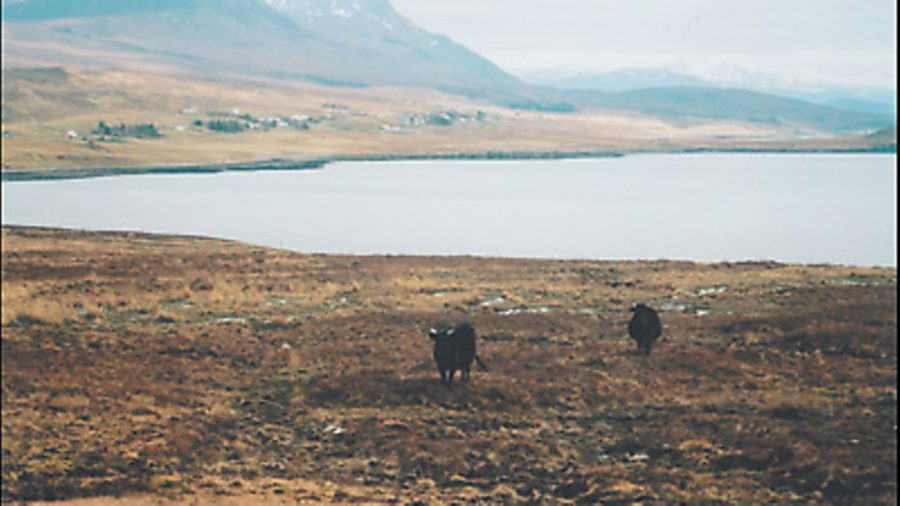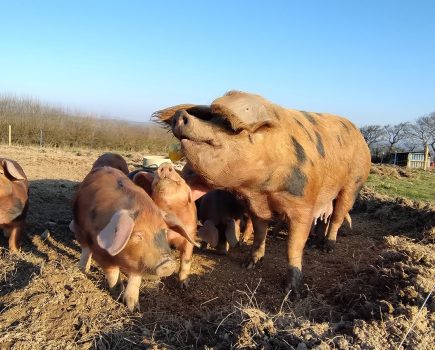Sharon Blackie lives on a croft but doesn’t rely on it to make her living
Crofts may exist in the most beautiful parts of the British Isles, but these are also the harshest and most disadvantaged areas of the country. Much crofting land is littered with rocks and stones, and is wet and boggy, and prone to invasion by rushes
When people think of crofting, the first image that springs to mind is often a romantic one. An old stone house with peat smoke spiraling from the chimney, mountains to the back of it and lush green fields at the front sloping down to the sea. And when they think of crofters? Healthy, rosy-cheeked pioneers at one with nature who make a living off the land.The reality is a little harsher. It may seem idyllic to outsiders, but there’s no doubt that it’s a tough way of life. In Wester Ross, where I live, most crofts can’t even sustain sheep all year round: they’re sent off east to the Black Isle for over-wintering, reducing the crofter’s profits and making it even harder to scrape a living from the croft. In this most westerly part of the country the rain falls and the wind blows for what sometimes seems like months on end. This year – after a mild and unusually dry winter that lulled us all into a false sense of security – the most severe snows and frosts arrived in March and April, just in time for lambing. But then spring always comes late here – the trees don’t begin to come into leaf till May. In June, just when you think you’re safe for the summer, prevailing north-westerly gales sweep down the loch and rip up the newly planted vegetable garden. And when summer finally arrives, it brings along with it a months-long plague of the dreaded Highland midge, the horror of which cannot be put into words. It has to be experienced to be believed!And yet, living on a croft has its compensations. Whatever the weather, the light and the landscape are spectacular. In late spring and summer, oyster catchers and eider ducks compete for attention along the lochside with herons. On early morning walks by the water, I’ll often see a solitary seal diving for a breakfast of fish, or a family of otters or, if I’m really lucky, a small school of porpoises sweeping in from the Summer Isles.But, wonderful as it is to live in a location like this, if I didn’t have other skills that I can sell (I’m a psychologist and a writer) the chances of making a living from the land alone would be slim indeed. I moved to this croft near Ullapool three years ago, and it’s been a source of constant surprise to me to discover how difficult it is for many crofters to break even, let alone make a living from crofting. So what exactly is crofting, why do so many people want to do it, and what really are the chances of making a go of it?What is crofting?Crofting is a form of smallholding unique to the Highlands and Islands of Scotland. Although it’s similar in some ways to other small farming systems in other parts of Europe, there’s nothing quite like it anywhere else in the world. A croft is, quite simply, a small parcel of agricultural land. The average size is around five hectares, but depending on the nature of the land, it can be anything from half a hectare to 50. Until recently, crofting land was always held in tenancy from a landlord. The rent paid by the crofter is usually very small and only for the use of the land: the croft house and any other agricultural buildings are for the crofter to provide, and so belong to him. Along with the tenancy of the croft, there usually comes a share in ‘common grazing’ land: land (often on the hills) held in common with other crofters in a township.Crofting is very much a way of life in the Highlands and Islands: there are just over 17,700 crofts and around 30,000 people live on them. Last year, 388 first-timers entered crofting and, if anything, the appeal seems to be growing.How did crofting begin? Crofting has a long history, and came into being as a consequence of events that led to what are now called the Highland Clearances. After the defeat of Bonnie Prince Charlie and the Jacobites at Culloden in 1746, the traditional clan system of land ownership in the Highlands fell apart. Over the next century, a variety of problems followed: over-population of the land, excessive sub-division of smallholdings, and natural disasters such as the potato famine that resulted in mass emigration overseas. Whole communities began to be forcibly cleared off their land by landowners to make way for more profitable enterprises such as sheep farming and the development of sporting estates. In the 19th century, crofters fought against landlords who were denying them their traditional rights. These land battles (often involving women and elderly people) attracted public attention and the Napier Commission was appointed to look into the issue on behalf of the government. Its report in 1886 led to the first Crofting Act, which for the first time gave crofters security of tenure – as long as they lived on the land and worked it.Acquiring a croftOver the years, other legislation passed has tightened up the rights of crofters. Today, crofters have the right to transfer their tenancies directly from one person to another – normally to a family member – and the only legal requirement is that the landlord accepts the new crofter as tenant. The Crofters’ Commission, an organisation set up in 1955, that now has the task to ‘oversee crofting legislation and develop crofting’, estimates that in a normal year, 400-500 tenancies are assigned in this way. Each year, 200 crofts may become available to those outside crofters’ families. However, most of these are directly transferred to people already known to the crofter.A small number of crofts come onto the open market each year. They’re usually advertised in a local newspaper so that interested parties may apply. Occasionally, crofters who wish to continue living on the croft but not work the land will sub-let or release the land to others.Increasingly, tenants of crofts are purchasing their land from the landlord. Since 1976, under crofting law, it has been legally possible for a crofter to acquire the title to his croft, becoming an owner-occupier. If he purchases his croft, however, he is legally required to live on it, otherwise he will be required to take a tenant who will work the land. Having bought the land, he may sell it to anyone he chooses, but the land is still crofting land and therefore subject to the restrictions governing such land – in other words, it must be worked as a croft. The Crofters’ Commission estimates that 3,500 crofts are worked by owner-occupiers and around 150 come onto the open market each year.What kind of people are crofters?For the past several years, crofting has been enjoying something of a renaissance and is attracting all kinds of people. A typical crofting community now will have incomers from all across the British Isles with little or no experience of smallholding, as well as the traditional crofters who have worked the land for generations. Many of these incomers bring new ideas for working the land and developing their crofts.And yet, crofting seems always to have been full of characters. Back in the ’70s, a woman lived alone in the croft next to mine with a cow and a handful of sheep. She must have been in her 40s when she took it into her head that she would like to be married. She put it about locally that she was looking, but no suitable bachelor to be found, she put an ad in the Stornoway Gazette, advertising for a husband. The story goes that one day, a man from Lewis came knocking at her door. He’d seen her ad and come across on a fishing boat to the mainland. He hitched a ride with a lorry to the end of the road, walked the five miles along the lochside to her house, knocked on her door and asked to be considered for the position. She looked him up and down, invited him inside, and after an hour and a couple of drams, it was all decided. She gave her cow to one neighbour and her sheep to another, signed over her croft and away she went with him, off to the islands.The futureAn increasing number of people are applying for crofts. In 2000, 67% of crofts that changed hands were passed from one family member to another. By 2005, that fell to 53%. More crofts are being bought and sold on the open market than ever before. A record 875 people are seeking a croft and have registered interest with the Crofters’ Commission – the waiting list is up 16% on two years ago and almost half of those who have registered their interest are under 40 years old. Crofters are increasingly diversifying into forestry, woodlands, renewable energy and tourist-related ventures.
This article is from the July 2006 issue of Country Smallholding magazine. << To order back issues click the link to the left.








